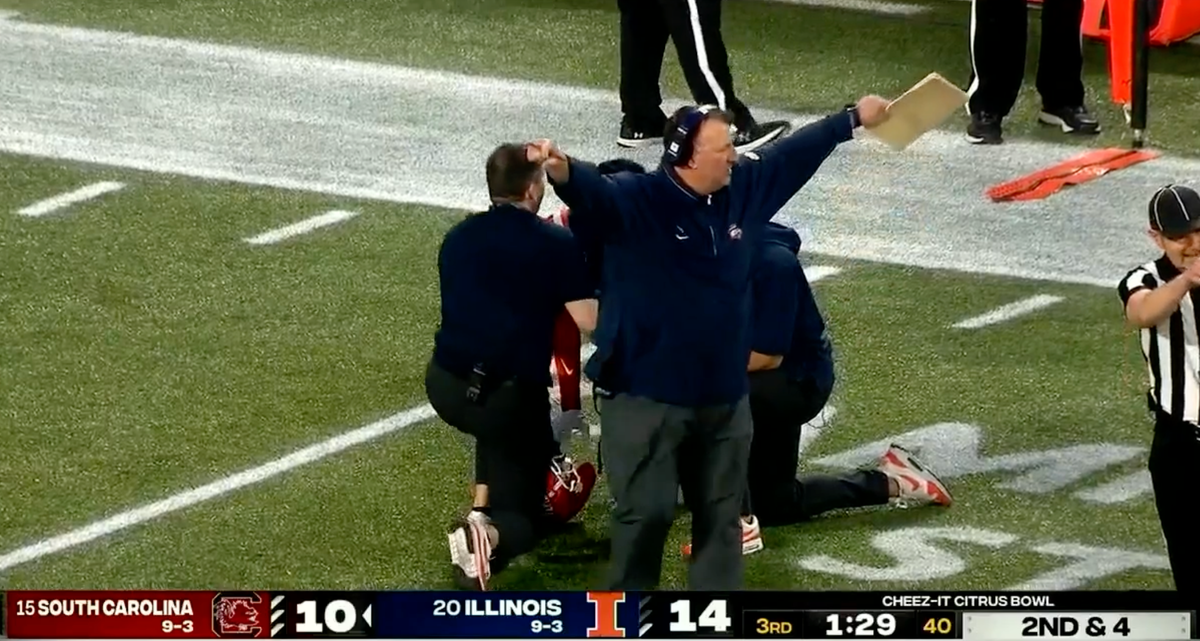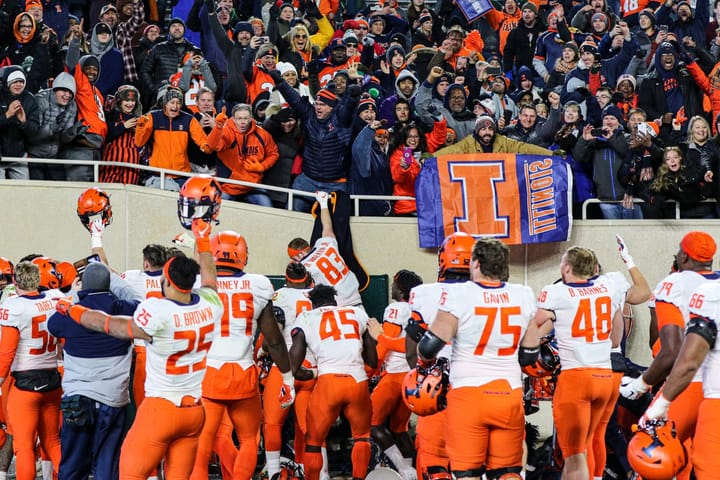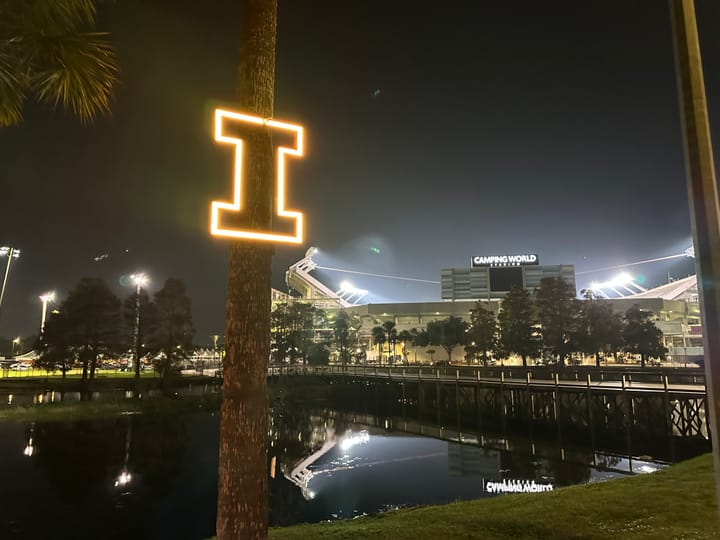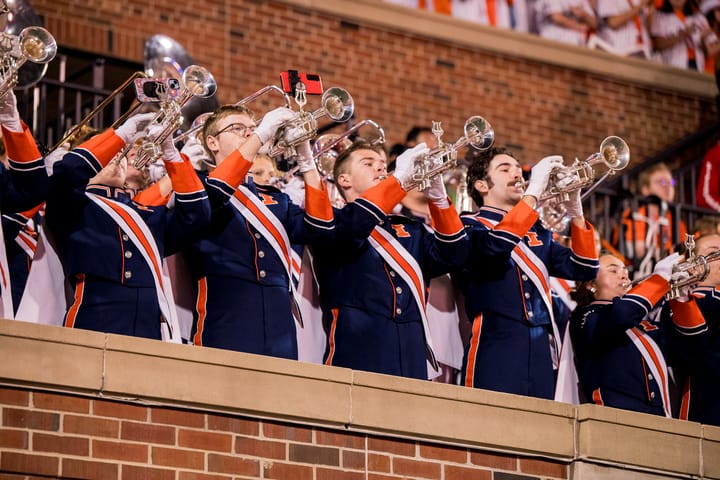PMP25: The T-Bar Thing

I had several "dealer's choice - you choose what article to write for my donation" responses this year. Especially the first few people to donate. So I'm knocking a few of those out and then I'll get to some of the questions sent my way.
If you don't know what I'm talking about, I do a fundraiser every May for a scholarship that is named after my dad. The campaign is closed now so a big thanks to everyone who helped us surpass our goal:

In exchange for the donations, I offer to write a "Pick My Post" for the donor. Several of the donors said "you pick", so this is the third "you pick" post. And it's a question I've gotten in person from several people during casual Illini conversations the last few months. Since I frame the question for all of these, I'll combine those in-person questions into this:
"What was the deal with the whole T-Bar thing? I know that Shane Beamer thought that Bielema was taunting their sideline's visible anger at the substitution delays, and I know that it also had something to do with a kickoff, but what is behind the signal itself?"
I was originally going to do a video explainer here, but then I realized that a video could get unwieldy (like the super-long explainer after the Wisconsin lineman touchdown in 2023). So perhaps the best way to do this is not to get bogged down in video clips or gifs or screenshots - maybe the best way to explain this is to pull back to a thousand-foot view.
First you need to know that the t-bar signal – two arms straight out – is used for two things on the football field. One is the referee (the white hat) holding his arms out allowing the defense to substitute if the offense has already substituted. The ball can't be snapped if his arms are out (and the umpire stands over the ball talking to the center and the QB until the ref's arms go down). The other is the unofficial (but now official) kickoff return signal that the returner in the endzone uses to let everyone know he's just gonna let it bounce in the endzone and take the ball at the 25. Let's talk about the second one first.
In college, if a kickoff lands in the endzone (if it bounces on the paint), it's a touchback. You used to have to grab it down it NFL-style, but years ago it was changed to the high school rule of "if it touches the endzone paint, it's a dead ball." This was a player safety rule change. Lots of injuries happen on kickoffs (full speed runs to go tackle the guy and whatnot), so a returner running to cover a loose ball in the corner of the endzone for a touchback while full-speed gunners are bearing down on him was a dangerous moment that was eliminated.
As you probably know, most kickoffs sail into (or out of) the endzone so the t-bar signal became a player safety thing. For those full-speed runners bearing down on the endzone after the ball is kicked, the t-bar became the "hey guys, this is gonna bounce in the endzone and I'm not gonna catch it so you can pull up and jog" signal. The ref can't blow his whistle to stop the play until the ball actually hits the turf, so it was an early "this is gonna be a touchback" signal to prevent some of the violent hits happening between the coverage team and the return team.
What South Carolina did on December 31st was have their guy do that signal, our players slowed to a jog and stopped trying to avoid South Carolina blockers, and then their returner dropped the signal, caught the ball in the endzone, and threw it to the other side of the endzone to another returner. The trick play did not work, and the Gamecocks did not fool the Illini coverage team, but the Illini coaching staff was not happy that a player safety "standard practice" was exploited for a trick play. This is why Bret Bielema, when Juice Clarke was injured near the South Carolina sideline later in the game, took the opportunity to put his arms out to say, essentially, "your returner's arms were out and by putting his arms back down, you're exploiting a player safety rule."
I fully agree with that. It's a driver waving you on at a four-way stop and then, after you go, hitting you and claiming it's your fault because they had the right-of-way. And when you say that the other driver waved you on, they claim that a hand signal isn't part of the law, it's just a courtesy and the other rules of right-of-way apply.
This won't happen anymore because it's now law. This offseason, the NCAA made it illegal to do the t-bar signal and then catch the ball and try to return it. They served as judge and jury and basically said "Bielema was right; Beamer was wrong."
But the other part of this is where all the confusion came in. When Bret Bielema made the signal to the South Carolina sideline, Shane Beamer interpreted it as being the other t-bar signal - the one the ref makes during substitutions. So Beamer saw it as a taunt and lost his mind. It was all sorted out in the postgame press conferences, and Beamer has since noted that he misinterpreted the signal, and now that the kickoff rule is changed, this thing is basically put to bed. The NCAA stepped in and said "Bielema is correct - you should not do that."
There's still some confusion however. And after 958 words, I'm finally going to tell you about it. The question that many seem to have: "Right, but why was the South Carolina sideline so mad about the substitutions in the first place? Why were the South Carolina fans booing? What was the deal with all of that?"
I'm glad you asked.
I think the best way to describe it is to talk Chip Kelly and other hurry-up offenses. When "tempo" became a thing in college football (over a dozen years ago), it changed some things about how the game was played. It was startling at first. "Wait, they're already running another play? We don't even have the defensive signal from our sideline yet. Hold on, they're running ANOTHER play already? Is this legal?"
The idea behind tempo was to catch you off guard. It wasn't just a game of "we run this offensive set and you counter with this defense" X's and O's. It was "we do this so quickly that you can't even set up your defense." The defense is on their heels, they're trying to sub in some players, and the offense is just BAM another play and BAM another play.
Fake injuries were born in this moment. Several coaches realized that they could stop the insanity if one of the defenders just fell down with a "cramp." They could regroup, substitute, make a new defensive call - anything, really. Could you really PROVE that guy didn't have an injury? What if it was just a quick cramp?
There have been several iterations of how the NCAA handled this between there and here. The biggest rule adjustment was that the defense could substitute if the offense substituted. The offense is running tempo, the defense is on their heels (and tired), but the offense just keeps lining up and lining up and you can't get your replacements on the field. Defensive coaches obviously complained about this (being able to position a defense in response to offensive personnel on the field is one of the core tenets of football), and so defenses were given an opportunity to substitute. Here's the text from the rulebook I found online:
e. When Team A sends in its substitutes, the officials will not allow the ball to be snapped until Team B has been given an opportunity to substitute. While in the process of substitution or simulated substitution, Team A is prohibited from rushing quickly to the line of scrimmage with the obvious attempt of creating a defensive disadvantage. If the ball is ready for play, the game officials will not permit the ball to be snapped until Team B has placed substitutes in position and replaced players have left the field of play. Team B must react promptly with its substitutes.
PENALTY − [e] (First offence) Dead-ball foul. Delay of game on Team B for not completing its substitutions promptly, or delay of game on Team A for causing the play clock to expire. Five yards from the succeeding spot [S21: SUB]. The referee will then notify the head coach that any further use of this tactic will result in an unsportsmanlike conduct foul.
(Second or more offence) Dead-ball foul, team unsportsmanlike conduct. An official will sound his whistle immediately. 15 yards from the succeeding spot.
So, big picture, think of all of this as a decade-long pushback from defensive coordinators against Chip Kelly (or whoever you want to use as the father of tempo). Defenses fought for "if they change their personnel, we have to be able to change our personnel even if they're running to the line and snapping it" and they got it. There's still tempo, and if an offense wants to run tempo with the same 11 guys on every play, the defense just has to try to keep up (or speed up their subs to the offense's same lightning pace). But the rule is now clear: if they sub even just a single player, the defense has to have an opportunity to sub.
What's an offensive response to that? Late-ish substitutions. That doesn't even have to be a tempo thing. The offense isn't running tempo but they want to go heavy without the defense being able to beef up the defensive line so they slyly (and very late) roll the big boys on and send the little guys out. What's the referee going to do? Allow the defense to then substitute and then force them into a delay of game?
Yes.
Let's go back to this play from the Citrus Bowl. Here's what to watch for:
- It's a goal-to-go from the one situation. So the offense could go heavy or they could go five-wide. There's probably no bigger play where defensive personnel matters than goal-to-go from the one.
- South Carolina starts with the same 11 from the previous play but then they run a fullback on and take a wide receiver off with around 29 seconds left in the play clock. The ref gives the t-bar signal allowing us to substitute. We run Alex Bray and Kenenna Odeluga on the field and run Luke Zardzin and Xavier Scott off. The South Carolina fans boo.
- Then South Carolina – remember the late substitution thing I mentioned above? – runs on a 6th offensive lineman and takes another receiver (I believe that's their tight end) off. And they do this with 10-12 seconds left on the play clock.
- The ref t-bars again. We counter with a heavy package because this just turned into "defend the barge" for us. The South Carolina fans boo with five times the volume.
- South Carolina has to take a timeout because the play clock is expiring.
Here's how it all played out:
What's the South Carolina offensive coordinator thinking? "With this package they just switched to, we can exploit that with a sixth offensive lineman. Run him on." What's Shane Beamer saying into the headset there? I'm not reading lips here but, paraphrasing, it's probably "Guys, you can't substitute that late. They will change their defense EVERY TIME and we'll have to take a timeout."
What are the South Carolina fans thinking? They're not. They don't have that ability.
HEY-OH.
No... what are the South Carolina fans thinking with their boos there? "They're cheating!! Bielema is having his guys slowly jog on the field and forcing us to call timeout. Penalize him! Have him face a military tribunal at the 50!"
But it's just ignorance. THIS is the decade-in-the-making defensive response to offensive substitution trickery. The response to "oh, did we slide an extra offensive linemen on the field late in the play clock with no chance for you to adjust? Sorry about that" is the t-bar signal and a substitution every time (even if you like the package you have in there). It's the defensive response to offensive tomfoolery.
South Carolina fans didn't understand this that night, but it's not Bret Bielema's fault that the South Carolina offense likes switching personnel so much in their attempt to create mismatches. If they wanted to stop the "hey ref he's barely jogging" substitutions, they needed to stick with their 11 guys on offense and run their plays. They switched all the time so we switched all the time. (And we had shown it on film all season so I'm not sure why they weren't ready for it.)
Yes, South Carolina fans, there have been times when Illinois fans booed our own team for doing this. There were a few plays in 2023 where a late sub from an opponent caused us to swap out defensive tackles (just because the t-bar was out and we could). And that switch-out took Johnny Newton off the field. One fan by me took to yelling "they're only subbing to get Newton off the field!" when this would happen. He was, uh, not a fan of the tempo-slowing defensive sub every time the t-bar arms went out.
But THAT'S what was happening that night. The South Carolina sideline was mad about the constant, take-your-sweet-time subs with the t-bar out. The Illinois sideline was mad at the player safety violation with the kickoff return t-bar. And because both signals for both plays somehow involve someone with two arms straight out, well, you got... all of that. Bret Bielema walking off with a trophy full of citrus and Shane Beamer looking across at the Illinois sideline and saying this:
Maybe I can read lips.




Comments ()